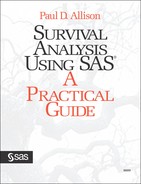Introduction
Prior to 1970, the estimation of survivor functions was the predominant method of survival analysis, and whole books were devoted to its exposition (e. g., Gross and Clark 1975). Nowadays, the workhorse of survival analysis is the Cox regression method discussed in Chapter 5, “Estimating Cox Regression Models with PROC PHREG.” Nevertheless, survival curves are still useful for preliminary examination of the data, for computing derived quantities from regression models (like the median survival time or the five-year probability of survival), and for evaluating the fit of regression models. For very simple experimental designs, standard tests for comparing survivor functions across treatment groups may suffice for analyzing the data. And in demography, the life-table method for estimating survivor functions still holds a preeminent place as a means of describing human mortality.
PROC LIFETEST produces estimates of survivor functions using either of two methods. The Kaplan-Meier method is most suitable for smaller data sets with precisely measured event times. The life-table or actuarial method may be better for large data sets or when the measurement of event times is crude. In addition to computing and graphing the estimated survivor function, PROC LIFETEST provides three methods for testing the null hypothesis that the survivor functions are identical for two or more groups (strata). Finally, PROC LIFETEST can test for associations between survival time and sets of quantitative covariates.
